
Railway preservation in New Zealand is the preservation of historically significant facets of New Zealand's rail transport history. The earliest recorded preservation attempt took place in 1925, although the movement itself did not start properly until 1960.

The Karangahake Gorge lies between the Coromandel and Kaimai ranges, at the southern end of the Coromandel Peninsula in New Zealand's North Island. A sharply winding canyon, it was formed by the Ohinemuri River. State Highway 2 passes through this gorge between the towns of Paeroa, Waikino and Waihi. This road is the main link between the Waikato region and the Bay of Plenty.
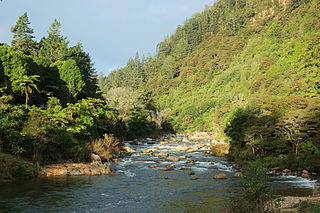
The Ohinemuri River is located in the northern half of New Zealand's North Island, at the base of the Coromandel Peninsula.

The Port Chalmers Branch was the first railway line built in Otago, New Zealand, and linked the region's major city of Dunedin with the port in Port Chalmers. The line is still operational today.

The Feilding and District Steam Rail Society, also known as Feilding Steam Rail, is a railway preservation society located in Feilding in the Manawatū region of New Zealand. The society has restored or is restoring a number of locomotives and wagons once used on New Zealand's national rail network, with its star attraction being a WAB class tank locomotive, WAB 794. The society also has X 442 and F 163. Although nine members of the F class are preserved, this is the only one in mainline running condition. The society also possesses two small diesel shunters, DSA 227 and TR 13, along with a large mainline diesel locomotive, DA 1401, and a varied collection of rolling stock including both passenger and freight wagons.

Waikino is a small settlement at the eastern end of a gorge in the North Island of New Zealand alongside the Ohinemuri River, between Waihi and the Karangahake Gorge. The Waikino district lies at the base of the ecologically sensitive Coromandel Peninsula with its subtropical rainforests, steep ravines and fast moving rivers and streams. The cascades of the Owharoa Falls lie just to the south west of the settlement.

The New Zealand DB class and DBR class locomotive is a type of diesel-electric locomotive built for service on New Zealand's rail network. They were built by General Motors Diesel (GMD) of Canada as a narrow-gauge version of the EMD G8 model, with seventeen locomotives constructed. Ten of these were later rebuilt into the DBR class.
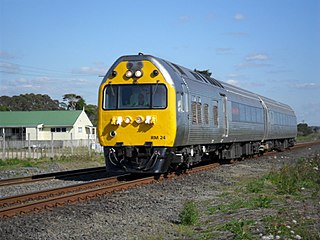
The RM class was the classification used by the New Zealand Railways Department (NZR) and its successors gave to most railcars and railbuses that have operated on New Zealand's national rail network. "RM" stands for Rail Motor which was the common name at the turn of the 20th century for what became known in New Zealand as railcars. As many types of railcars are operated, class names have been given to each railcar type to differentiate them from others.
The Taneatua Express was an express passenger train operated by the New Zealand Railways Department that ran between Auckland and Taneatua in the Bay of Plenty, serving centres such as Tauranga and Te Puke. It commenced in 1929 and operated until 1959.

The East Coast Main Trunk (ECMT) is a railway line in the North Island of New Zealand, originally running between Hamilton and Taneatua via Tauranga, connecting the Waikato with the Bay of Plenty. The ECMT now runs between Hamilton and Kawerau, with a branch line to Taneatua from the junction at Hawkens. The line is built to narrow gauge of 1,067 mm, the uniform gauge in New Zealand. It was known as the East Coast Main Trunk Railway until 2011, when the word "Railway" was dropped.

Steam Incorporated, often abbreviated to Steam Inc., is a railway heritage and preservation society based at the Paekākāriki railway station, Paekākāriki at the southern end of the Kāpiti Coast, approximately 50 minutes north of Wellington on the west coast of New Zealand's North Island. Unlike some societies who operate on preserved sections of closed branch lines, Steam Incorporated owns a depot beside one of the country's most important railway lines, the North Island Main Trunk railway, and restores heritage locomotives and rolling stock for use on excursions on the regular national rail network.

A & G Price Limited is an engineering firm and locomotive manufacturer in Thames, New Zealand founded in 1868.

The Kaimai Tunnel is a railway tunnel through the Kaimai Range in the North Island of New Zealand. Since it was opened in 1978, it has held the title of longest tunnel, at 8.879 kilometres (5.517 mi), in New Zealand, assuming this distinction from the previous title holder, the Rimutaka Tunnel. It is part of the Kaimai Deviation, which was constructed to bypass the old route of the East Coast Main Trunk Railway through the Karangahake Gorge.
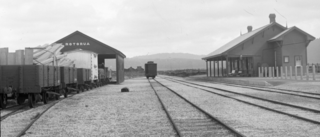
The Rotorua Branch is a railway line from Putāruru to Rotorua, in the Waikato and Bay of Plenty regions of the North Island of New Zealand. Construction of the line was commenced by the Thames Valley and Rotorua Railway Company and finished by the Public Works Department (PWD). The complete line, 50.5 kilometres (31.4 mi) in length, opened in two sections; on 24 November 1893 to Tārukenga and the final 8 mi 43 ch (13.7 km) to Rotorua on 8 December 1894.

The Thames Branch railway line connected Thames, New Zealand, with Hamilton and was originally part of the East Coast Main Trunk railway. Part of the line between Morrinsville and Waitoa remains open and is in use as the Waitoa Branch line, connecting to the Fonterra Dairy Factory at Waitoa.
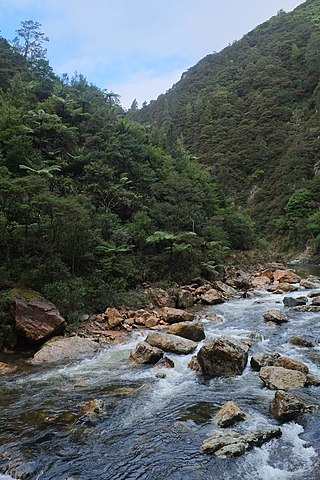
The Waitawheta River is a river of the Waikato Region of New Zealand's North Island. It flows from a point south-east of Mount Te Aroha in the Kaimai Range to the Karangahake Gorge at the foot of the Coromandel Peninsula to reach the Ohinemuri River at Karangahake, five kilometres east of Paeroa.
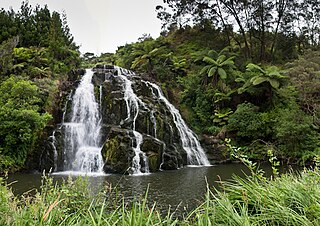
Owharoa Falls is a staircase waterfall in Waikato, New Zealand, located off Waitawheta Road in Karangahake Gorge, near State Highway 2, between Paeroa and Waihi, and close to the small settlement of Waikino.

The Hauraki Rail Trail is one of the Great Rides of the New Zealand Cycle Trail system, using parts of the abandoned ECMT and Thames Branch railways in the Hauraki Gulf plains and the Coromandel Peninsula.
The Tāneatua Branch is a 25 kilometres (16 mi) long branch railway line in the Bay of Plenty, New Zealand, running from Hawkens Junction, west of Edgecumbe, to Tāneatua.

The Waihi-Waikino Gold Tramway was a narrow-gauge railway which ran between gold mines at Waihi and the Victoria Battery at Waikino. Owned by the Waihi Gold Mining Company, it operated from 1897 to 1952. It was the only private railway in New Zealand used by the gold industry.



















